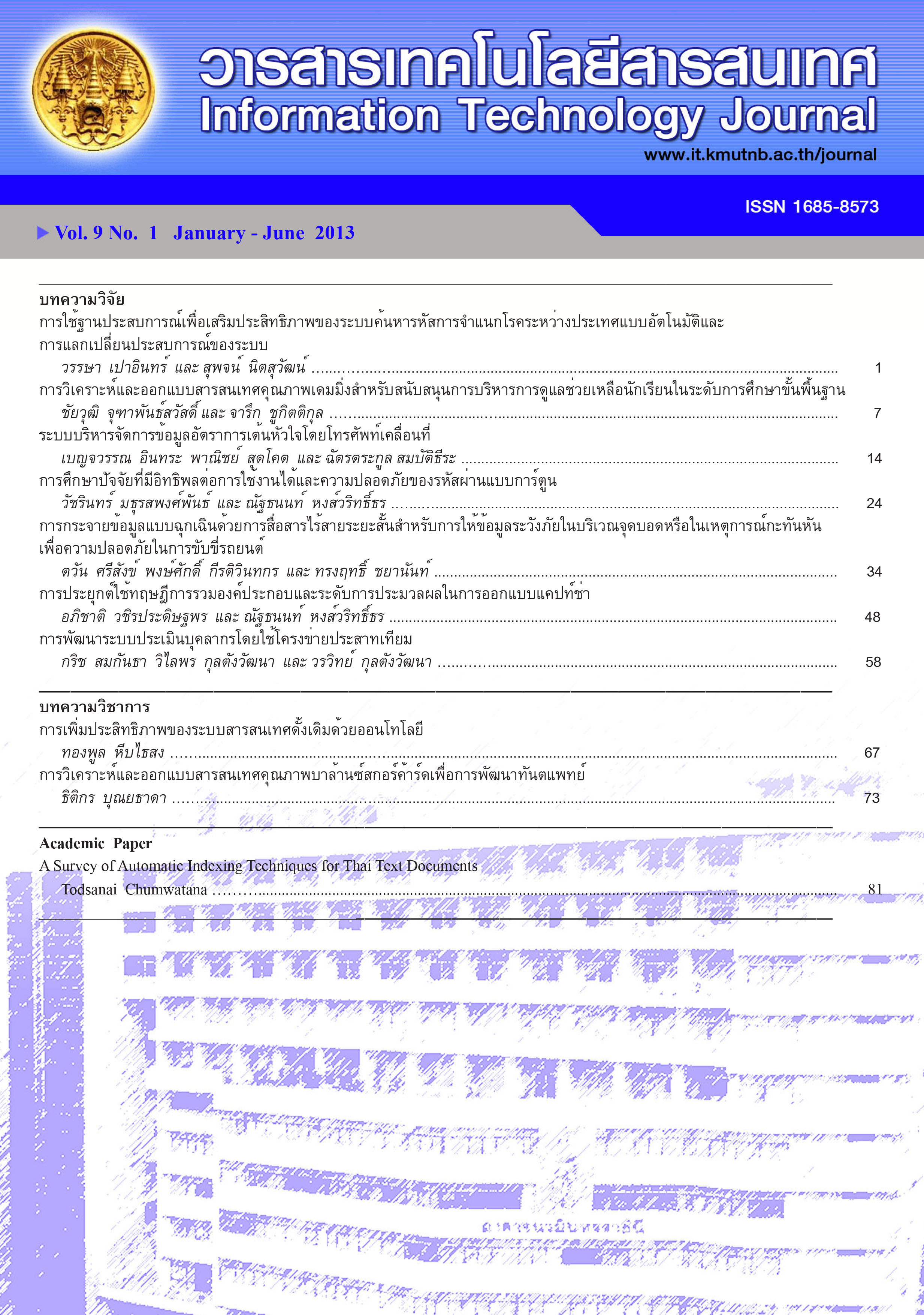การค้นคืนข้อมูลพระเครื่องจากภาพดิจิทัล โดยเทคนิคการสกัดคุณลักษณะและวิธีเพื่อนบ้านใกล้สุด
Main Article Content
Abstract
งานวิจัยนี้เป็นการนำเสนอการค้นคืนข้อมูลพระเครื่อง จากภาพดิจิทัลโดยใช้เทคนิควิธีเพื่อนบ้านใกล้สุดมีวิธีการคือ นำภาพพระเครื่องแม่แบบ และภาพทดสอบจากกล้องดิจิทัล ที่ถ่ายภาพในสภาวะควบคุม อาทิเช่น การควบคุมระยะห่าง ระหว่างกล้องถ่ายภาพ ชิ้นพระเครื่อง ความเข้มของแสงใน การถ่ายภาพ และพื้นหลังของวัตถุ เป็นต้น งานวิจัยนี้เน้น การค้นคืนข้อมูลพระเครื่องแบบเนื้อผง คุณสมบัติที่ใช้ใน การสกัดข้อมูลภาพ ใช้การวิเคราะห์โครงร่างพื้นผิวภาพด้วย เมทริกซ์ระดับเทา (Gray-Level Co-Occurrence Matrices : GLCM) โดยเก็บค่าการคำนวณทางสถิติจากการวิเคราะห์ โครงร่างพื้นผิวภาพ 10 รูปแบบ และทำการทดสอบระบบ โดยใช้แบบพระเครื่องชนิดเนื้อผงทั้งหมด 44 แบบ มีภาพทั้ง สิ้น 1,400 ภาพ แบ่งเป็นข้อมูลภาพต้นแบบ จำนวน 880 ภาพ ข้อมูลภาพทดสอบเป็นภาพที่ระบบได้รู้จำแล้ว จำนวน 440 ภาพ ภาพที่ระบบยังไม่ได้รู้จำ จำนวน 440 ภาพ ผลของการประเมินประสิทธิภาพความแม่นยำ (Precision) ของระบบ เท่ากับ 98.87% สำหรับภาพที่ไม่ได้รับการรู้จำ
Buddha Amulet Information Retrieval using Digital Images Combined with Feature Extraction and K-nearest Neighbor Techniques
Patompon Fugthong and Phayung Meesad
The purpose of this research is to develop an information retrieval system to aid the identification of Buddha amulets. The information will be processed based on the K-nearest neighborhood technique which will identify each type of small or large Buddha amulet from a database. The texture analysis technique was applied in order to extract 10 features from images taken with a digital camera in the retrieval process. Moreover, a white paper background was used in each picture to insure a high standard of resolution, as most amulets are made from soil it is necessary to photograph them at close range. The study used the characteristics of Buddha amulets to design the classification algorithms, which consisted of ten feature extractions with texture analysis from Gray-Tone Spatial-Dependence Matrices or (Gray-Level Co-Occurrence Matrices: GLCM) to find the statistical texture measure. The experiments were conducted on more than 1,400 images from 40 different kinds of small Buddha amulets. The training data set was at around 880 Buddha amulet images. The system was tested using 440 images from the training data set and 440 images from the non-training data set. The result of these experimental tests yielded precision at 98.87% from the un-train test set. In conclusion, this developed system achieved all goals successfully.


